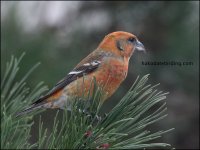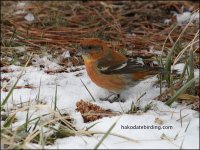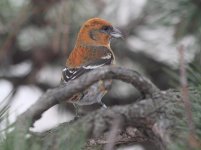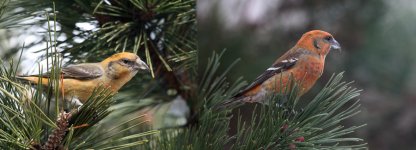Such individuals are always quite difficult. Let's start by ageing the bird. It has still lots of greenish feathers for example on the throat, so it's a 2cy bird. On White-winged Crossbills, juvenal greater and median wing coverts have much narrower white tips than adult ones, so the thickness of the wing bars isn't an excluding factor. Also the colour tone of the red plumage isn't necessarily a good feature (and I wouldn’t rely too much on structural features). Here's a 1cy male White-winged Crossbill (September) for comparison (this one has very worn juvenal feathers on the wings):
http://www.birding.se/foto/bandelkorstnabb.jpg
White-winged Crossbills often moult some of the inner greater upperwing coverts by the first winter, which makes the identification easier, but I believe that this is not always the case (
compare to the moult of Common Crossbill). Here’s a first winter male White-winged Crossbill with moulted inner greater and median coverts:
http://www.tarsiger.com/images/Roope/B_lox_leu2_6961.jpg
one of the fieldguides suggest male Common Crossbills sometimes have incomplete white markings on the wings...
AFAIK white tips on the wing coverts of Common Crossbills is not a sex-related feature, but more of an age-related feature, i.e. juvenal coverts may have white tips of varying width. Whichever species the subject bird is, I believe that all of the greater coverts are still juvenal. I'm not completely sure about the median coverts, as the outer ones have clearly narrower tips, but I'd say that they are also all juvenal (adult type median coverts would have broader tips on White-winged Crossbills, and lack white tips on Common Crossbills).
One of the features that has been used to id such individuals is the shape of the white tips on the greater coverts. On common Crossbills the white colour continues along the edges of the feathers, while White-winged Crossbills have more square cut white tips. The median coverts have U-shaped white tips on Common Crossbills, while the tips are again more square cut on White-winged Crossbills. Both of these features indicate that the subject bird is a White-winged Crossbill, but I’ not completely sure how reliable they are.
Here are two more immature White-winged Crossbills:
http://www.tarsiger.com/images/antero/Looksi325.JPG
http://www.kolumbus.fi/rantala.rant...as to Emb/Loxleu/loxleu 02syy Mustas 9130.jpg
Here’s an immature (probable) Common Crossbill with broad wing bars (but note the shape of the tips of the greater coverts):
http://www.bongariliitto.fi/kuvat/2...ipot/loxcur_20010208_helsin_kompe/loxsp2x.jpg
Adult male Two-barred Crossbills have rather dark scapulars, like J. Moore wrote, but it’s not always easy to judge, compare to this bird, whose adult type scapulars have rather broad red fringes:
http://www.artportalen.se/artportalen/gallery/Image.aspx?rappsyst=0&obsID=11768543&imageID=67542
Note also that quite many of the scapulars of the subject bird might be juvenal (they have greenish edges).
Hearing the calls of the bird would make the id easy.










